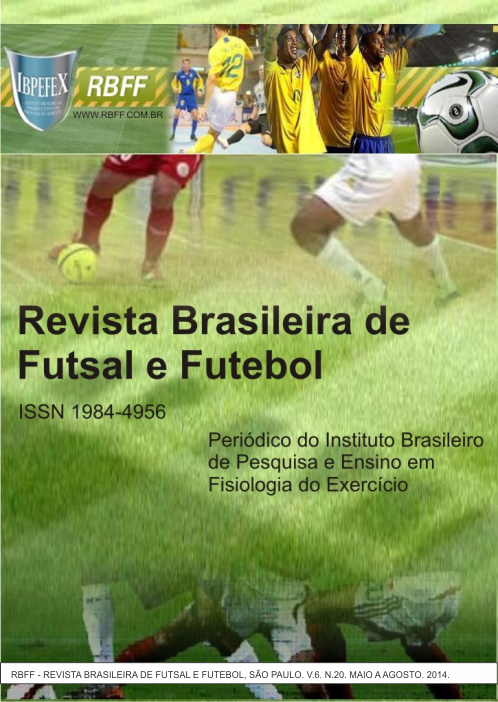Alterations of indicators neuromuscular inathletes of futsal during a macrocycle
Abstract
The Futsal is a collective modality of the fastest growing in recent years, however, research on the performance of the sport are configured in a recent approach in the area of sports training. Thus, the aim of this study was to observe the changes of neuromuscular indicators of youth futsal athletes over a macrocycle, using periodization by Selective Cargo (Gomes, 2002). We selected 14 male athletes with a mean age of 16.8 ± 0.36, 170 ± 3.67 cm tall and 67.1 ± 4.15 kg. The athletes underwent anthropometric assessments and tests to check the neuromuscular abnormalities: running 20 meters to evaluate the speed, horizontal jump to evaluate the strength of lower limbs and the Illinois Agility Test to assess agility. Control tests were performed at three different times, in order to evaluate the effects of periodization applied, the first at the beginning of training (T1), the second after the preparatory period (T2), and third in the final period competitive (T3). For statistical analysis we used the mean and standard deviation and the Shapiro-Wilk test for normality, p <0.05. The results showed a gain of neuromuscular performance indicators from the preparatory period until the end of the competitive period. From the results obtained, it can be concluded that the periodization model-based Selective Loads caused a significant increase in speed, agility and explosive strength athletes, being a periodization model suitable for use in futsal.
References
-Cyrino, E. S.; Altimari, L. R.; Okano, A. H.; Coelho, C. F. Efeitos do treinamento de futsal sobre a composição corporal e o desempenho motor de jovens atletas. Revista Brasileira de Ciência e Movimento. Brasília. Vol. 10. Núm. 1. 2002.
-Confederação Brasileira de Futsal de Salão. Disponível em: <http://www.cbfs.com.br.> Acesso em: 15/08/2013.
-Generosi, R. A.; Baroni, B. M.; Ferrari, M. Leal Junior, E. C. P. Níveis de aptidão física relacionada a saúde e ao desempenho motor de adolescentes praticantes de futebol e futsal. In: XI Encontro Latino Americano de Iniciação Científica e VII Encontro Latino Americano de Pós-Graduação. Universidade do Vale do Paraíba. 2008.
-Gomes, A. C. Treinamento Desportivo: Estruturação e periodização. Porto Alegre. Artmed.2002.
-Gonzeles, M. P.; Riuz, J. B. La velocidade em fútbol sala. Lecturas enEducación Física y Deportes. Revista Digital, Buenos Aires. Ano 8. Núm. 47. 2002.
-Lage, I. P; Hermida, M. S.; Ferrenõ, O. Q.; Lópes, O. M.; Castro, S. D. Las capacidades físicas em el jugador de fútbol sala: bases para el entrenamiento. Revista Fútsal Coach. Madri.2006. Disponível em:. Acesso em 15/07/2013.
-Matos, J. A. B.; Aidar, F. J.; Mendes,R. R.; Lomeu, L. M.; Santos, C. A.; Pains, R. Capacidade de aceleração de jogadores de futsal e futebol. Fitness e Performance Jornal. Vol. 7. Núm. 4. p. 224-228. 2008.
-Passos, W. S.; Alonso, L. A influência do treinamento de futsal na velocidade e agilidade de escolares. Lecturas en Educación Física y Deportes. Revista Digital, Buenos Aires. Ano 13. Núm. 129. 2009.
-Pellegrinotti, I. C.; Daniel, J. F.; Cielo, F. B. L.; Cavaglieri, C. R.; Neto, J. B.; Montebelo, M. I. L.; César, M. C.; Análise da potência anaeróbia de jogadores de futebol de três categorias, por meio do teste de velocidade para potência anaeróbia (TVPA) do running-based anaerobic sprint test (RAST). Arquivos em Movimento. Rio de Janeiro. Vol. 4. Núm. 2. 2008.
-Projeto Esporte Brasil. PROESP-BR. Universidade Federal do Rio Grande do Sul. Disponível em:<http://www.ufgrs.br/esef/proesp-br> Acesso em: 15/02/2013.
-Roozem, M. Illinois Agility Test. NSCA’s Performance Training Journal. Vol. 3. Núm. 5. p.5-6. 2004.
-SantiMaria, T.; Arruda, M.; Almeida, A. G. Futsal: treinamento de alto rendimento. Phorte. 2009.
-SantiMaria, T.; Arruda, M.; Hespanhol, J. E. Características antropométricas e desempenho físico de jogadores de futsal sub-20 de diferentes posições táticas. Rev. Bras. Med. Esporte. Vol. 13. Núm. 1. p. 8. 2007.
Authors who publish in this journal agree to the following terms:
- Authors retain the copyright and grant the journal the right of first publication, with work simultaneously licensed under the Creative Commons Attribution License BY-NC which allows the sharing of the work with acknowledgment of the authorship of the work and initial publication in this journal.
- Authors are authorized to enter into additional contracts separately for non-exclusive distribution of the version of the work published in this journal (eg, publishing in institutional repository or book chapter), with acknowledgment of authorship and initial publication in this journal.
- Authors are allowed and encouraged to post and distribute their work online (eg, in institutional repositories or on their personal page) at any point before or during the editorial process, as this can bring about productive change as well as increase impact and impact. citation of published work (See The Effect of Free Access).





